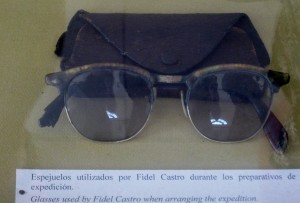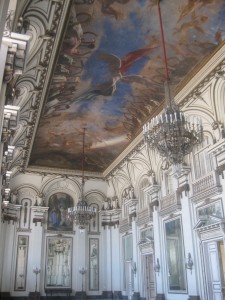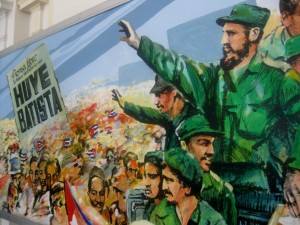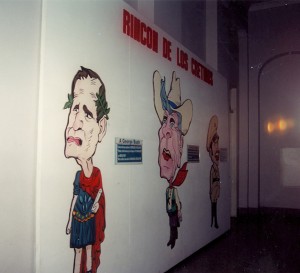Museum of the Revolution: To preserve history or to prefer the goals of the revolution?
April 1, 2012 by mamielke
During our afternoon of free time in Havana, I took the opportunity to visit the Museo de la Revolución in Old Havana.
The museum is housed in what was formerly the official presidential palace for all Cuban presidents. Fulgencio Batista was the final occupant before the victory of the 1959 revolution. The palace is beautifully imposing; it is difficult to imagine that this was ever someone’s residence. When I visited, there was fairly intense scaffolding around the exterior of the palace, and I am still not quite sure how long of the process those renovations have been.
It cost 6 CUC to enter the museum, and another 2 CUC for the usage of cameras. At the museum’s entrance, someone in my group noticed that it was considerably cheaper for Cubans to enter, an equivalency of cents rather than dollars. I thought it was wonderful that it was so cheap for Cubans to visit this site of national pride. However, even for tourists, 6 CUC is a considerably reasonable price for entrance into such a historical place.
As we entered the museum, we were ushered to the top floor to begin the chronological journey through the progression of Cuba’s revolution. The first room gave a history of the palace’s construction, and the following rooms gave brief accounts of Cuba’s independence from Spain. The majority of the museum’s artifacts were devoted to the revolutionary fight of the 1950s, as well as the post-1959 period.
The collection of artifacts was quite interesting. They had patches of the 26th of July Movement, army fatigues worn by guerilla soldiers, personal items of important revolutionary figures, and many more little trinkets. It was somewhat strange to see so many artifacts that belonged (belong?) to the Castro brothers, symbols of the revolution that are still alive today. I suppose this is similar to Bill Clinton’s saxophone in the Smithsonian Museum of American History, or any other such item, but said artifacts seem to be more focused on a cultural value than in building a narrative of heroism in terms of the country’s leaders.
Unlike the Che Guevara monument and museum, it was perfectly acceptable to talk and take pictures within the museum, and there was a fairly lively atmosphere within this historical space. Most of the stories were told with photographs and captions, with the artifacts adding to the narrative.
One of my favorite parts of the museum was the palace ballroom, which contained a very interesting mural of an angel carrying the Cuban flag on the ceiling, while other angels heralded Cuba’s independence from Spain. I initially thought that it was refreshing how this ballroom was kept intact for historical record, as opposed to claiming it for the second revolution. However, I then began to think that it could be just as easily applied to the 1959 revolution, and perhaps that it why it was preserved. However, this pessimism was diminished later by the fact that the museum chose to preserve the presidential office. This office, assumingly of Batista’s reign, required an extra fee to enter this space. This served as another example of a space saved for history rather than for pure revolutionary goals.
I was actually surprised by the lack of overt government propaganda in this museum. Perhaps this is because all museums of a historical nature attempt to tell the story of the country and it’s people as the government hopes to tell it. The Museo de la Revolución seemed like a museum that might be found in any country. On face value, one difference that I noticed was that this museum seemed to have less resources than other museums might have for upkeep or etcetera.
However, near the exit of the museum, I quickly walked by a display of cartoons, one that was definitely recognizable as George H. W. Bush and a few other figures that I could not immediately place in my memory. Upon returning home, and through some pretty intense googling, I found an image of this collection of cartoons. It was titled “Rincon de Cretinos” or corner of the cretins, and it is exists as a very telling analogy between former presidents George H. W. Bush, Ronald Reagan, and Fulgencio Batista. This seemed to be the only overt symbol of anti-Americanism endemic within the museum. It is interesting that the museum chose to have tourists and non-tourists alike end their tour with these images, as opposed to an image of the victory of the revolution.
Leave a Reply
You must be logged in to post a comment.




